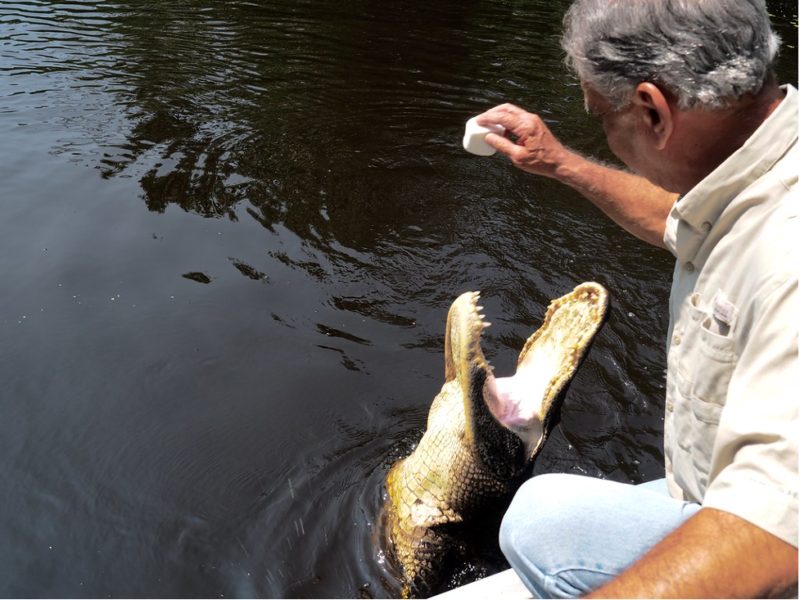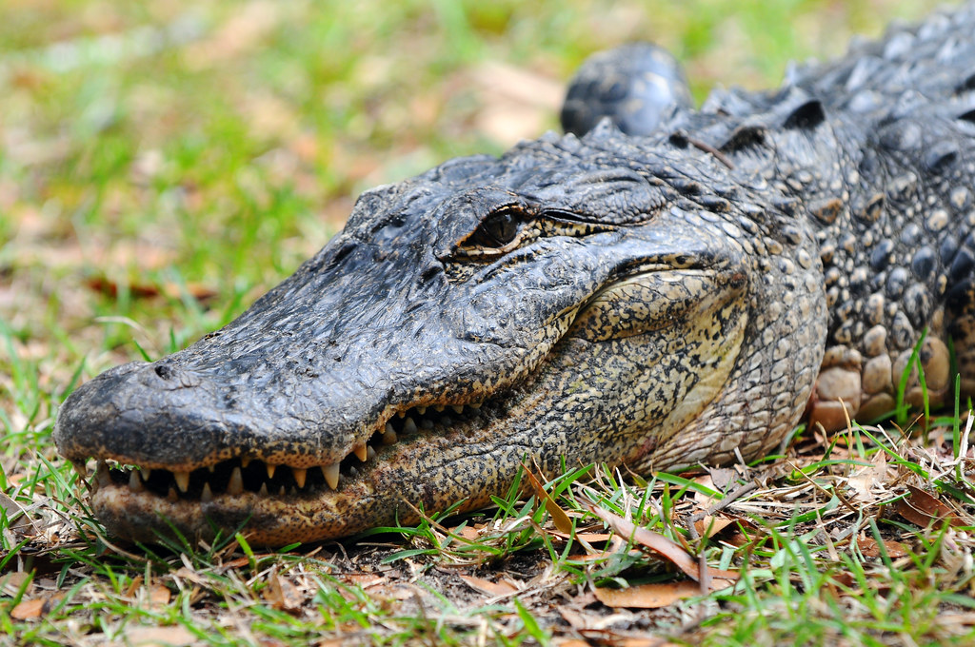Alligators are the largest reptile in North America, with the largest discovered alligator reaching an impressive 19ft and 2 inches (a whopping 2,000 pounds). As these cold-blooded creatures live in fresh and brackish water, our Louisiana swamps and marshes offer the ideal environment. These massive beasts can cool themselves off in the wetlands’ saturated marsh and sunbathe on the water banks. These magnificent creatures have been around for 225 million years, a figure that requires more than a moment to fully process. With a lifespan stretching to an average of 75 years, these muscled bodies have incredible strength in their tail, allowing them to swim up to 20 miles per hour. These animals are idolized throughout the state, evident in both home décor and as the essential ingredient in New Orleans’ Alligator soup. Celebrated as a key component of New Orleans culture, these animals exemplify Louisiana’s resilience-rooted culture.
New Orleans makes a tradition out of swamp tours, touting them as an essential experience to appreciate the beauty of the wetlands. A simple Google search of “New Orleans Swamp Tours” will provide you with an endless list of businesses that cater to Alligator Tourism. Starting as low as $30 a ticket, these accessible swamp tours bring a significant contribution to New Orleans tourist revenue. This niche tourism is a multimillion-dollar industry! People come from far and wide to hop onto an airboat (or a kayak if they’re feeling confidently adventurous) and coast through the bayou, taking in the wildlife around them. Passengers “ooh” and “ahh” on the occasion an alligator decides to come out to say hello.

Picture of alligator poking head out of the water (Photo by: Zach Werner)
Louisiana has the highest population of wild alligators, around two million, with our American Alligators making up the majority. Their diet grows in size from the beginning of their life (mostly crawfish, small fish, and frogs) to adulthood (animals as large as deer). However, alligators have been developing new tastes for their human-fed diet of marshmallows. Swamp tour guides entertain their crowds by baiting these large animals with food. As people toss marshmallows into the bayou, these alligators mistake these sugary snacks for eggs as they swim out to greet their guests and grab a bite.

Photo of a man feeding an alligator a marshmallow (Photo by: E Kat)
Swamp tours are not the only way you’ll find alligators munching on sugar. It is not uncommon for children to attend class field trips and birthday parties at Alligator Ranches, where kids get the opportunity to hold alligators the size of their forearms, with the alligators’ snouts wrapped tightly with a thick rubber band, of course. One can only imagine the potential lawsuits if this protective measure was not put in place. Barn doors open to reveal alligator tubs for the audience to witness the power of these animals. Forming this mass of thickly skinned bodies, alligators crawl over each other to retrieve baby marshmallows that have been tossed over the barrier between the children and them. Children and adults alike screech and squeal at the sound of alligators’ jaws clapping shut in their competition for food.
Now, the airboats utilized in most swamp tours (even those equipped with mufflers) are incredibly loud, surpassing 90 decibels, a sound loud enough to cause damage after 8 hours of exposure. Often, passengers are equipped with noise-canceling headphones, but what about the animals subjected to this noise pollution without consent or protection? Not to mention, alligators and other animals of the Wetlands exhibit hyper-auditory senses. While these airboats roar onwards to their wildlife hot spots, drivers blow through brush and saturated waters, thrashing the marsh below and the micro-ecosystems that inhabit them. All of this to finally witness the thrill of a wild alligator, tour guides push the limits to appeal to their customers. They creep their watercraft up as close to alligators as possible, not forgetting to positively reward their compliance with a treat, once again: the convenient marshmallow.
Alligators are already facing adversities with our environmental climate. The temperature at which eggs are maintained affects the sex of the hatchling! An egg incubated at a temperature of 93°F and above will result in a male, while those incubated at 86°F or below will result in a female. Now, drawing a connection to climate change, the increase in temperature can potentially create more males than females. This disproportion of males to females can harm the species and lead them into endangered territory, as natural reproduction rates would be affected by this disparity. Not to mention the impending stress of our rising sea levels with each hurricane scare- these animals cannot tolerate saltwater for a long period of time. We do not have the room to take advantage of these animals and disrupt their ecological balance. For example, alligator mothers build mounds to protect their eggs and provide habitable homes for other species. Their nests also provide recycled use for turtles and snakes to hatch their eggs. Take away the alligator, take away their proximate relations.

Up-close photo of an alligator in the grass (Photo. by: Florida Fish and Wildlife)
These swamp tours and alligator ranches claim that they educate the public about these incredible animals. In reality, they are prolonging the problem, all the while hiding behind a disguised motive. Ranches can steal eggs from their nests and incubate them to be raised in captivity. It is legally required that only 10% of these alligators (not rightfully any human’s property) are returned to the wild before they reach two years. Here’s the kicker: the remaining 90% are slaughtered for their meat and skin or directed towards lucrative tourism. It would be quite ironic if alligators, which survived the era of dinosaurs, met their fate at the hands of humans.
In Swamp Tour Louisiana, alligators are seen for their monetary value. The focus on keeping them alive is motivated by their bodies’ revenue (an impressive 60-70 million dollars a year). This income is booming due to the murders of innocent animals that are targeted for their strength. This massive revenue is only further cycled into these franchises buying or stealing eggs for the intended use of captivity. Alligators are objectified by human fear, and from this, they are losing their lives, whether that be through the sale of their glazed heads in gift shops or through poachers stripping their skin for monetary benefit. Despite the Endangered Species Act, the cruel and unjust treatment of these animals has prevailed. As tourists chase wildlife, they subject these animals to detrimental abuse as they support businesses that cause physical damage to our Wetlands’ ecosystems. What about these animals makes it reasonable to manipulate their every survival instinct? Disrupt their diet, damage their habitats, hunt their bodies, steal their skin, display their heads on the mantle, and call it Cajun Pride! At the end of the day, Louisiana’s alligators are learning to become dependent on the resources of their abusers. It is not just a marshmallow; it represents a stepping stone in these animals’ corrupt treatment as objects of commodification.
 NOLAbeings Multimedia artist Claire Bangser created NOLAbeings as a portrait-based story project that marries...
NOLAbeings Multimedia artist Claire Bangser created NOLAbeings as a portrait-based story project that marries...  Voodoo in New Orleans: Reviving history: New Orleans fortune telling This article takes a deep dive into the history of Voodoo in New Orleans, its hybridization with Catholicism, and its present-day place in the city's culture. The author visits fortune-tellers in the French Quarter, using their guidance as a tool for introspection rather than a deterministic predictor of the future. Through her experiences in New Orleans, the author feels a mystical connection to both the past and the future.
Voodoo in New Orleans: Reviving history: New Orleans fortune telling This article takes a deep dive into the history of Voodoo in New Orleans, its hybridization with Catholicism, and its present-day place in the city's culture. The author visits fortune-tellers in the French Quarter, using their guidance as a tool for introspection rather than a deterministic predictor of the future. Through her experiences in New Orleans, the author feels a mystical connection to both the past and the future. 